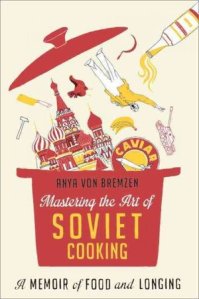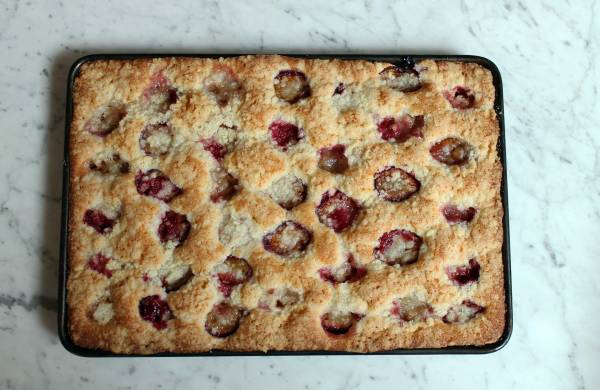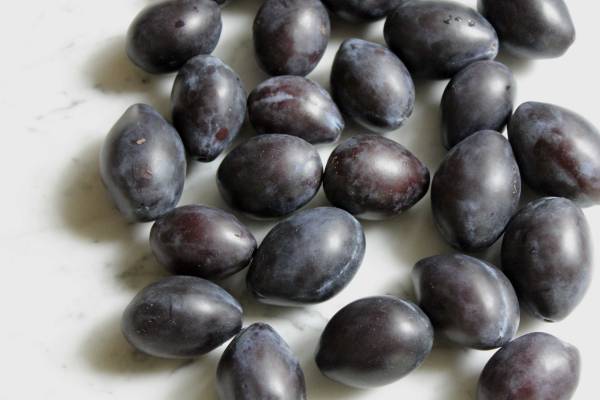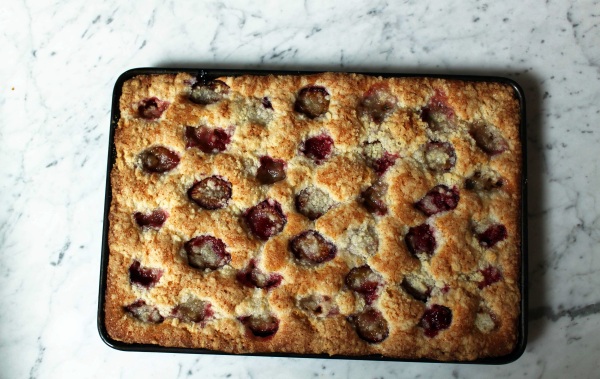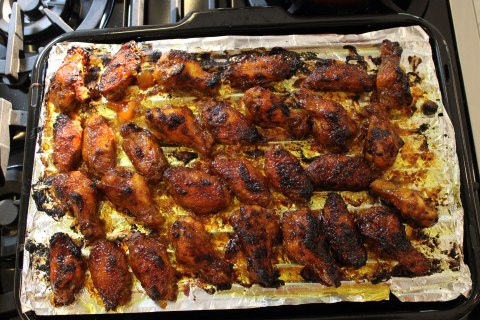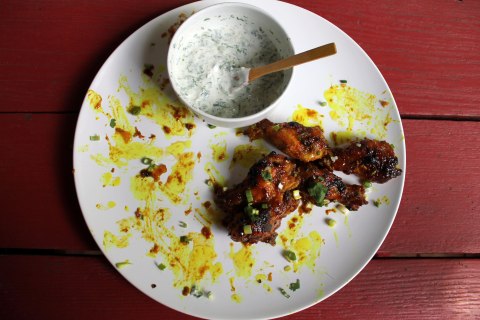I thought I knew what I was getting into when I brought this book home. Anya von Bremzen is a Russian émigré and this is her memoir of food and eating weaved together with her family history and the history of the Soviet Union, each chapter representing a decade of their collective past. Just by the topic alone, I knew I was going to really, really like it. Then I read it. And bozhe moi (my god), I loved it.
Anya and her mom Larisa salivate over Chekhov short stories and Gogol’s Dead Souls. They aren’t the only Russian authors to make them smack their lips; Pushkin and Tolstoy have the power, too. I majored in Russian language and literature and I was, and still am, absolutely, completely unaware of the delicious treasures in these stories. Maybe when I was reading these authors in university I was more into chicken wings, beer and nachos (still am – for the record) and I just didn’t get it. I’m a bit more cultured now. Or I hope I’m a bit more cultured. Maybe it’s time to reread Dead Souls just for the food.
That’s not my only revelation from this book. In the chapter on the 1930’s, Stalin’s commissar of Soviet food production went to the United States to research American food. He returned with the ways and means to give the Soviet citizenry the hamburger; American hamburger grills were purchased and installed in major Soviet cities, enough to turn out 2 million orders a day. But when WWII happened, the bun got lost in the shuffle. The hamburger patty – no longer sandwiched between bread – became a kotleta. My mom used to make these when I was growing up! This failed Soviet attempt at the American hamburger had even made its way to the far western reaches of the Soviet empire. I remember wondering why we ate them with a knife and fork when it was so clearly a bizarre kind of burger. I would get two slices of bread out of the pantry, splash the kotleta with some ketchup and eat it like that. Deep down inside, I always knew its heritage was hamburger.
In the chapter “1970s: Mayonnaise of My Homeland,” we find out that mayonnaise is literally the glue that holds the Soviet Union together and its infinitely repurposed jar an invaluable vessel for anything a Soviet citizen might need to carry or contain – from spring flowers to booze (obviously) to pregnancy samples. Anya writes about the mayonnaise jar:
“Specifications of a totem: short, 250-gram, pot-bellied and made of glass, with a tight-fitting lid. If, as Dostoyevsky supposedly said, all Russian literature comes out of Gogol’s story “The Overcoat”, then what Gogol’s garment was to nineteenth-century Russian culture, the Provansal mayonnaise jar was to the domestics practices of Mature Socialism.”
She just equated a mayonnaise jar to the importance of Gogol’s “The Overcoat” to Russian culture, and name dropped Dostoevsky. I’m dead.
This book has so much to give – an embarrassment of food riches – that I was overwhelmed with choice on what to make for Food Anthology. The rightful star of the mayonnaise chapter is the famous Salad Olivier – the king of potato salads. But we’ve already covered that dish here. The first chapter, “1910s: The Last Days of the Czars,” gives us kulebiaka, the over-the-top bejeweled Fabergé egg of all fish pies, with its layers of sturgeon, blini, mushrooms, and dilled rice enveloped in a rich and buttery yeasted dough. I loathe fish pies but I was so under the spell of this book that I almost agreed to spend three grueling days cooking some Russian imperial era dish that I would never eat. The kotleta from the 1930’s chapter is a dish not worth eating. I’d rather have McDonald’s.
In the 1980’s, Anya and her mom return to Moscow, having emigrated to America the previous decade. They receive an invite to have dinner with Anya’s dad, someone who has a lot to apologize for. The care with which he created each dish and the monthly budget he spent to buy a whole chicken is meant to show how sorry he is. For dinner – a masterfully robust and savoury borscht and Georgian walnut-sauced chicken; to drink – homemade walnut-infused samagon and a lingonberry sprit. But to start – a canapé of gratinéed cheese toasts made with Friendship Cheese, cilantro and adzhika. Anya forgives him. It’s not clear if her heartbroken mom did, though.
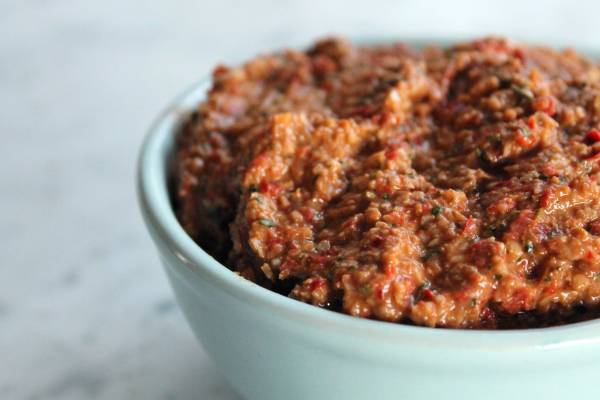
Adzhika, a spicy Georgian condiment, made with hot red peppers, walnuts, garlic and cilantro
There are different styles of adzhika, a spicy Georgian type of pesto, but it always includes hot peppers, garlic, spices and herbs. Friendship Cheese, a Soviet invention from the 1960’s, is a processed soft cheese spread.
This zakuska (Russian for little bite) is great with drinks, from cocktails to, if you’re brave enough, something as luridly strong as the home crafted lingonberry infused 100 proof ethyl alcohol Anya’s dad served for the forgiveness dinner.
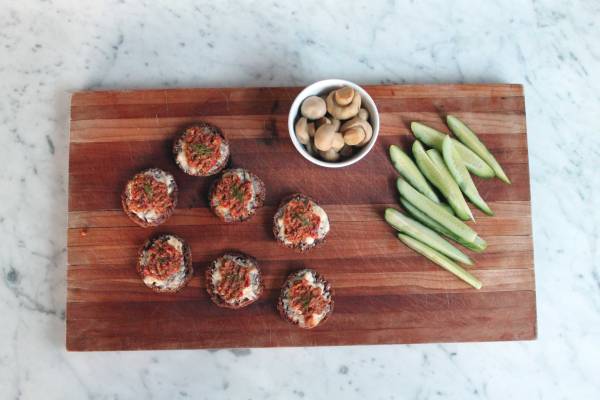
Adzhika topped cheese toasts as part of a zakusky platter with pickled mushrooms and summer pickles
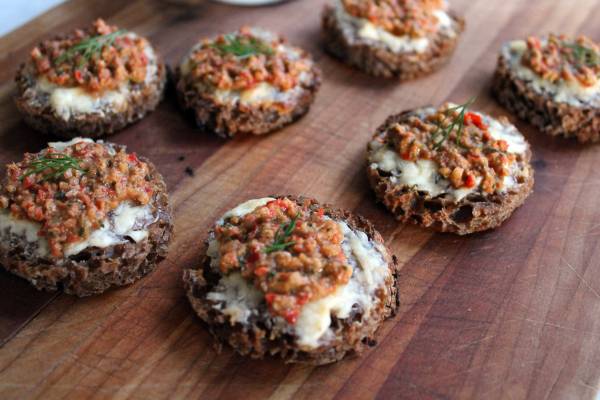
Toasted dark rye rounds with cheese and a walnut, cilantro and hot pepper adzhika
Forgiveness Canapés with Walnut, Cilantro and Hot Pepper Adzhika
For the walnut, cilantro and hot red pepper adzhika:
Original recipe here. I made a quarter of this recipe.
The quantities below yield about 1 1/2 cups.
10-12 red hot peppers
20 garlic cloves, peeled
3/4 to 1 cup walnuts
a good handful of cilantro, leaves and stems
1 tablespoon dried coriander
1 1/2 teaspoons dried summer savoury
1 tablespoon olive oil
2 tablespoons white vinegar
4 good pinches of kosher salt
Remove the seeds from the peppers.
Put the first four ingredients into a food processor and pulse until the mixture is a rough paste. Add the dried herbs and pulse a few more times. Pour the adzhika into a bowl and stir in the olive oil and vinegar. Season to taste with salt. I found the paste needed four good pinches of salt. You might find you need less or more.
To assemble the canapés you’ll need:
Sliced dark rye bread
Processed, spreadable cheese product (or Friendship Cheese if you can find it!)
Adzhika
Fresh herbs to garnish (cilantro, chives or dill are good)
Depending on how many canapés you’d like to make, that’s how much bread you’ll need. You’ll have about 1 1/2 cups of adzhika, so that can be your guide on the maximum quantity of canapés you’ll be able to make.
I cut rounds of the dark rye bread using a cookie cutter. If you don’t want to be that elaborate – and you don’t want want to have unusable bread scraps – you can always cut the bread into squares or rectangles.
I couldn’t find Friendship Cheese in Toronto but what I did end up getting is La Vache Qui Rit (Laughing Cow) brand cheese spread made with goat’s cheese. I have no idea what Friendship Cheese tastes like so I was kind of in the dark in finding something that was similar in flavour. I do know that Eastern European groceries and delis sell processed cheese spreads from a bunch of different manufacturers. It would be fun to experiment with different processed cheese! (Never thought I would say that on this blog.)
Spread some of the cheese onto the dark rye pieces and toast/broil until the the bread has toasted on the edges and the cheese is bubbling and bronzed. Top the gratinéed cheese toasts with a dollop of the adzhika. Garnish the toasts with a bit of the fresh herbs.
Serve with drinks.
Cleveland’s a Plum Cake
This statement makes no sense at first glance. It’s because I stitched two not so related stories together by a not so obvious thread: seasonal stone fruit.
In the 1970s and 80’s, Cleveland’s reputation was in the pits. We’re not talking plum pits. We’re talking a bottomless, dark, scary pit where crawling out seemed impossible. When all anyone talked about was the river catching fire, city officials tried to turn its reputation around by coming up with a tourism campaign that would make people like Cleveland and want to visit. They came up with this:
New York might be the Big Apple, but Cleveland’s a Plum.
To help sell this, the mayor pitched a plum at a Cleveland Indians New York Yankees game. That didn’t help.
This slogan is so woefully naïve. And goofy and hopeless. But looking at it now, it’s charming because of those reasons. Cleveland isn’t as obviously great as New York. But it has tons of gems, great food, real grit, great neighbourhoods and one of the best markets in the country. Cleveland’s a plum of a city for sure. (Sorry, had to go there).
With plums in season right now, in piles outside of my neighbourhood’s greengrocers, I’ve been dying to make my mom’s plum cake. I got on the phone to Cleveland to get her recipe. You should know by now that all plum stories lead back to Cleveland. Looking at the list of humble ingredients, you’d think that this cake isn’t anything special. Don’t be fooled. This cake doesn’t look obviously great, but it’s beautiful and delicious and a plum would be hard pressed to find a better exit. And don’t be tempted to add any nutmeg or cinnamon or fancy brown sugar. This cake has enough charms already.
This type of cake is called a plyatsok in Ukrainian. I hesitate to call it a sheet cake because that just makes it sound like it’s chocolate or vanilla and it gets icing on top. It’s not that at all. It is a cake baked in a wide shallow baking sheet (more on the size later) but it’s definitely not a fluffy cake that has candles plopped in it. It’s on the thinner side but its crumb is tender and soft. As the cake bakes, each piece of fruit creates its own little nook, where it becomes soft and snuggles into its own syrupy sweetness. Plyatsok is a homey, comforting thing perfect with a cup of coffee or tea.
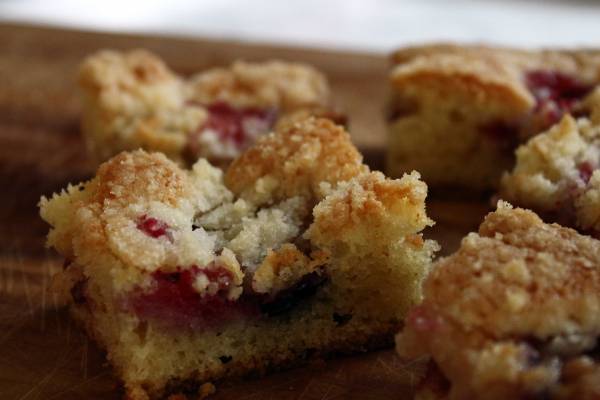
Ukrainian Plum Cake (from Cleveland)
A recipe from my mom.
A few things about this recipe before we start.
My mom stressed the importance of using a wide shallow pan at least three times as she dictated the recipe to me over the phone. She said that this is where people screw it up by not using the right sized pan. She didn’t provide an actual pan measurement, just that it must be wide, shallow and that 13 x 9 is definitely the wrong size. I pulled out all of my wide shallow pans that weren’t 13 x 9 and then guessed which one would work best. I picked the 15½ x 10½ and crossed my fingers. That size baking pan totally worked and the plum cake turned out perfect.
This cake is not sponsored by Dr. Oetker. But there are certain little kitchen helpers that my mom likes to use and in this recipe it’s Dr. Oetker baking ingredients. Since I wanted this cake to be exactly how she makes it, I didn’t change a thing. I listed the measurements on the packets if you wanted to substitute another baking powder or your own vanilla sugar.
I love this cake using plums but blueberries are perfect, too. Sour cherries or peaches or nectarines would definitely work. And why not rhubarb? I could keep going but I think you get the picture.
For the cake:
1 cup butter, softened
4 eggs
1 cup sugar
1 9-gram packet Dr. Oetker vanilla sugar
2 cups all-purpose flour
1 14-gram packet Dr. Oetker baking powder
About 16 Italian prune plums, sliced in half and pitted
For the streusel topping:
about ½ cup all-purpose flour
about ½ cup sugar
½ cup butter, cold and cut into small cubes
Preheat the oven to 350 F. Place rack in the middle of the oven. Butter a 15½ x 10½ baking sheet.
First, make the streusel topping. Put the cubed butter into a medium bowl and then add a bit less than ½ cup each of the flour and sugar. The measurements in making this always differ slightly for me. So, start with a bit less and then add as you need. Using your hands, rub the flour, sugar and butter together until you get little clumps forming. You don’t want the clumps to feel too buttery or sticky. They should feel dry to your hands. You’ll be sprinkling these on top of your cake so keep in mind the size of the clumps. You want them to be smaller than a smallish pebble. Set aside when done.
Using a stand mixer, whisk eggs using a medium to medium -low speed. Add the softened butter and keep whisking until incorporated as best as possible. The butter will still be a bit clumpy. Add the sugar until the mixture is almost smooth.
In a separate bowl, whisk together the flour, vanilla sugar and baking powder. Then whisk the flour mixture into the eggs, sugar and butter. You’ll need to stop mixing occasionally and using a spatula, push the batter down into the bowl so it can all be mixed well. When the batter is smooth, it’s done. It will be thick.
Scoop/pour the batter into your baking sheet. Using an offset spatula, smooth and even out the batter. Top the cake batter with your plums, cut side up. As you place them, press the plums down gently into the batter. You don’t want them pressed down all the way until they hit the pan. Just press them down a wee bit. Sprinkle a nice layer of the streusel over the cake. You’ll want good coverage.
Bake the cake for about 45 minutes or until puffed up and golden brown.
Chicken Wings and Marriage
Food is one of the main ingredients when trying to partner up with someone. When the dating becomes something a bit more serious, those let’s-go-out-for-dinner-dates become come-over-my-place-I’ll-cook-for-you-dates. You cook for someone, or even better, you cook together, chatting together in the kitchen, having wine, feeling really excited because it’s all going so well. And then it gets even better: you discover that this guy has pretty decent knife skills and knows it’s best to clean as you go. When in the throes of serious but still kind of early dating, there’s cooking but not the type of cooking just to get by. The dishes have to have some fuss about them: there’s fancy stuff, ethnic stuff, fun stuff, exotic stuff, there’s dessert and multiple courses and themed dinners and menus copied out of cookbooks of famous chefs. This curried chicken wing recipe was discovered when I started dating Orest. That was about 11 or 12 years ago. Looking at it now, it doesn’t seem that this recipe had enough fuss about it for me to want to make this for us. But back then this dish counted as exotic because it had curry powder in it (I’ve come a long way) and I had to figure out who this Major Grey is and why he makes chutney. And obviously, chicken wings are always a winner.
Orest and I got married a few weeks ago. A wedding where we tried to keep it simple still ended up being so all consuming in the final month leading up to the event. But now that the party planning and organizational acrobatics are done, we’re back to the heart of it all – a happy relationship that endures. This recipe, like the relationship, has made it over a decade. Its original splotched print out is still in my recipe binder. To celebrate our marriage and to get back into the swing of writing on Food Anthology, I thought to write a wedding-ish post about cake or champagne or something else that obviously shouts celebration. But that didn’t feel right. I made this dish a few nights ago when it hit me that this dish is “it,” that celebratory wedding recipe I thought to write about. Here we are, sitting down at the table more than decade later with a dish we thought was a keeper way back at the beginning.
Crisped Curry Chicken Wings with Coriander Cucumber Yogurt
That’s alliteration if I ever saw it.
Adapted a bit from epicurious.com.
20-25 split chicken wings
4 tablespoons curry powder
6 tablespoons Major Grey’s chutney, any large mango chunks minced
2 tablespoons fresh lemon juice for the marinade plus 1 teaspoon for the yogurt sauce
3/4 teaspoon salt
1/8 teaspoon cayenne
1 tablespoon soy sauce
¾ cup plain yogurt
about ½ cup of seeded and grated cucumber
a small bunch of cilantro, minced, plus some cilantro springs for garnish
chopped green onion
In a bowl stir together the curry powder, 2 tablespoons of the chutney, 2 tablespoons of the lemon juice, cayenne, and salt. Add the wings and toss to coat them well. Let the wings marinate, covered and chilled for at least 4 hours or overnight.
Preheat the oven to 475°F.
In a small bowl stir together the remaining 4 tablespoons chutney and the soy sauce. Arrange the wings, marinade discarded, on the oiled rack of a broiler pan*. Bake them for about 25 minutes. Brush the wings with the soy-sauce mixture and broil them under a preheated broiler about 4 inches from the heat for 1 to 2 minutes, or until they are crispy and dark caramel coloured and a bit burnt in places.
To make the yogurt sauce, stir together the yogurt, cucumber, minced coriander, 1 teaspoon of lemon juice, and salt to taste.
Transfer the wings to a platter, garnish them with the coriander sprigs and chopped green onion, and serve them warm or at room temperature with the yogurt sauce.
This a great party appetizer but it can also be a main dish if you love chicken wings (like I do).
Makes enough for 2 as a main dish (with maybe a couple leftover).
*broiling the wings with the chutney glaze can make for extremely tough cleaning of the rack, that chutney glaze becoming a shellac. If you’re not keen on soaking and scrubbing, you can line the rack with aluminum foil for easy clean up. However, during the baking time, you’ll need to flip the wings over so the underside can have contact with the hot air to crisp up the skin all around.
